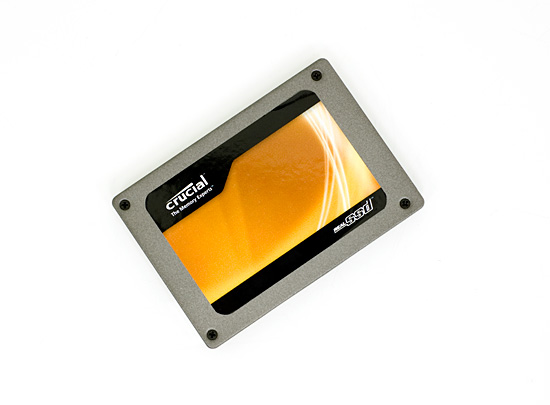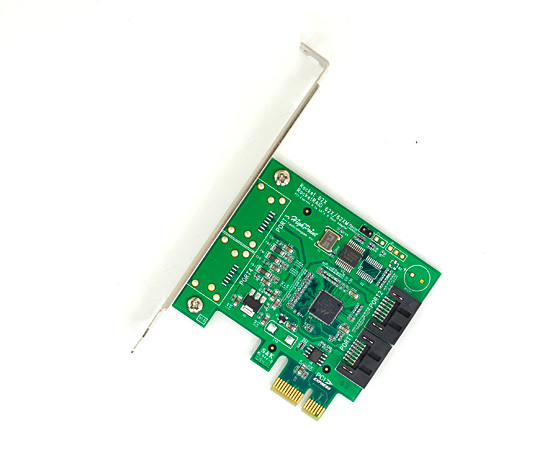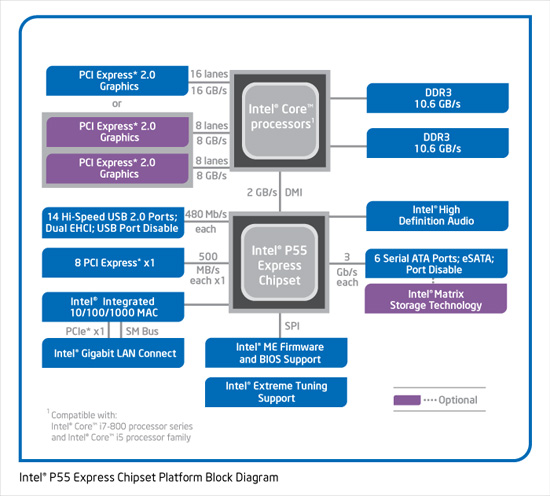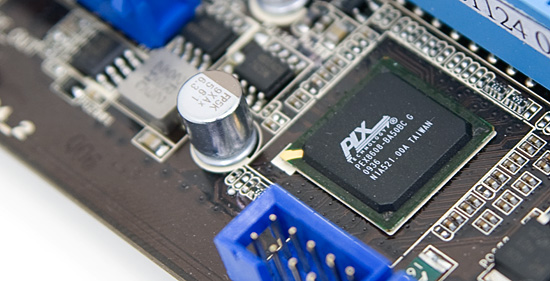6Gbps SATA Performance: AMD 890GX vs. Intel X58/P55
by Anand Lal Shimpi on March 25, 2010 12:00 AM EST- Posted in
- Storage
Crucial’s RealSSD C300 - The Perfect Test Candidate
The C300 is capable of pushing over 300MB/s in sequential reads. More than enough bandwidth to need 6Gbps SATA as well as expose limitations from PCIe 1.0 slots.

To test the C300 I’m using Highpoint’s RocketRAID 62X. This PCIe 2.0 x1 card has a Marvell 88SE9128 6Gbps controller on it.

What About P5x/H5x?
Unlike Intel’s X58, the P55 and H5x chipsets don’t have any PCIe 2.0 lanes. The LGA-1156 Core i7/5/3 processors have an on-die PCIe 2.0 controller with 16 lanes, but the actual chipset only has 8 PCIe 1.0 lanes. And as we’ve already established, a single PCIe 1.0 lane isn’t enough to feed a bandwidth hungry SSD on a 6Gbps SATA controller.

Gigabyte does the obvious thing and uses the PCIe 2.0 lanes coming off the CPU for USB 3 and 6Gbps SATA. This works perfectly if you are using integrated graphics. If you’re using discrete graphics, you have the option of giving it 8 lanes and have the remaining lanes used by USB 3/SATA 6Gbps. Most graphics cards are just fine running in x8 mode so it’s not too big of a loss. If you have two graphics cards installed however, Gigabyte’s P55 boards will switch to using the PCIe 1.0 lanes from the P55/H5x.
ASUS uses the same approach on its lower end P55 boards, but takes a different approach on its SLI/CF P55 boards. Enter the PLX PEX8608:

The PLX PEX8608 combines 4 PCIe x1 lanes and devotes their bandwidth to the Marvell 6Gbps controller. You lose some usable PCIe lanes from the PCH, but you get PCIe 2.0-like performance from the Marvell controller.
For most users, ASUS and Gigabyte’s varying approaches should deliver the same results. If you are running a multi-GPU setup), then ASUS’ approach makes more sense if you are planning on using a 6Gbps SATA drive. The downside is added cost and power consumed by the PLX chip (an extra ~1.5W).










57 Comments
View All Comments
sparkuss - Thursday, March 25, 2010 - link
Anand,I was going to maybe get two C300's for my current build. Do we consumers need to wait for your update before we invest in these?
We know it died, but I haven't been able to find any other reliability statistics collated anywhere to make a buying decision on.
sparkuss - Thursday, March 25, 2010 - link
Sorry, I missed the Update link in the upper corner.vol7ron - Thursday, March 25, 2010 - link
Great review. Not much to be said. There was a little bit of puffery at the end, in AMDs favor.I'm sure most companies have faster controllers/BIOSs to be released. Rather than saying AMD is something to look out for, for some reason I'd think Intel would have something greater.
As you mentioned, the on-die controller should have lower latencies - could you ask them about this? Perhaps some of the PCI bandwidth is being chewed up by something else, or perhaps the latencies are too low, causing a check/repeat bottleneck? (or maybe this a marketing ploy to release something faster in the future)
Dzban - Thursday, March 25, 2010 - link
Because AMD has native 6Gbps and they are improving drivers. With intel chipsets you can't phisicly increase speed further.vol7ron - Thursday, March 25, 2010 - link
I don't like how Intel switches between [Mb/s & Gb/s] and [MB/s & GB/s]. It'd be nicer to not have to translate 480Mbps into 60MB.I guess the issue was at first past I almost equated the 480Mb/s to the 500MB/s right under it.
jejeahdh - Thursday, March 25, 2010 - link
You should not type dates in that format, and if you had an editor, he or she should absolutely stop you from doing such things. People have expectations. You might think it's no worse than the ever-present traditional ambiguous formats of the US and Europe (m/d/yy(yy), d/m/yy(yy)) which are bad enough, but at least it's an old and well recognized problem that people are used to living with, so long as it uses slashes. People with knowledge of standards, though, use dashes for ISO date format, yyyy-mm-dd which is also perfectly sortable. By mixing and matching styles haphazardly, you're only propagating the notion that anything goes, causing people to stop and wonder for 12 days out of every month. If you're deliberately adopting the style commonly used in the Netherlands (I had to look it up) and advocating its use for an international audience, I cannot imagine why.I know it seems crazy to harp on this and I kind of agree . . . but I am just so surprised to see it here, written by a detail oriented technically minded accomplished writer.
strikeback03 - Friday, March 26, 2010 - link
If this is in response to the IOMeter build, that might be the way it was named by its creator, not Anand. Also, I would imagine 6-22-2008 is m-dd-yyyyassassin37 - Thursday, March 25, 2010 - link
Hey Anand, Why isn't the X-58 gigabyte native 6gbs board on the write benchmarks?assassin37 - Thursday, March 25, 2010 - link
never mind I read why, legacy modevailr - Thursday, March 25, 2010 - link
Intel releases SSD friendly AHCI/RAID driver:http://www.pcper.com/#NewsID-8538">http://www.pcper.com/#NewsID-8538